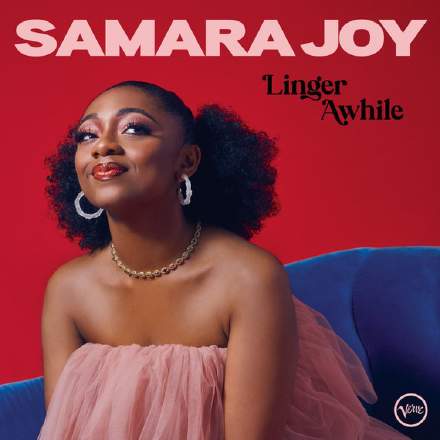
Walking away with both Best New Artist and Best Jazz Vocal album at this year’s Grammies, Samara Joy is clearly one of the hottest tickets in town at the moment, and plenty has already been said about her rich vocal timbre, impressive technical chops, and interpretative maturity. Listening to a few cuts from the album (Linger Awhile), however, I couldn’t quite shake the impression that her performance was lacking some of the magic of her popular live videos on Tiktok and Youtube – things like these versions of ‘I’ll String Along With You’ and ‘Autumn Nocturne’, or indeed the live version of this very song at the Grammies ceremony. It’s almost as if, in attempting to refine her performance for recorded posterity, she’s played things a little too safe.
The vocal production likewise feels just a fraction over-controlled to me. The pitching of some held notes (such as “mood” at 1:07) seems to teeter precariously on the boundary of synthetic statis, for instance, while overall the quantised pitch-grid somehow exerts slightly more power on the singer’s pitch-centres than feels appropriate for the musical style and the tone of the lyric. Don’t get me wrong – whatever editing’s been done is first-class, but I just wish the editor’s Strength setting had been set a notch lower.
And, in a similar vein, although the vocal holds its place in the balance with commendable solidity, I wonder whether the firmness of the dynamics control is robbing us of some of the drama of the vocal performance. Listen to the section from 2:51 to 3:10, for example, and notice how the more powerfully performed words “tell you that I love you” (2:55) don’t really seem to make quite the impact you’d expect them to following the softer preceding words “wasn’t part of my scheme, to sigh and”. Or how the words “get out” at 3:07 seem to loom almost larger in the mix than the preceding “can’t”, even though it sounds to me as if the singer is performing “get out” significantly more softly. Now, I’m used to hearing this kind of thing all the time in the mainstream charts, where extreme balance control is so critical for melody and lyric transmission to comparatively inattentive audiences. But on a jazz record like this, I think I’d have preferred that the performer’s artistic nuances had been given slightly freer rein. To be fair, though, it’s a really tough judgement call, and one I’ve frequently struggled with myself on a number of different projects – it’s very easy to get overzealous with the fader-tweakage later in the mix process, when objectivity becomes hardest to maintain.
But enough of the nit-picking – something that I do like a great deal about this production is the sound of the backing band. The tone and cohesion of the drums, bass, and piano just feel so natural and believable, notwithstanding the basic conceits of a modern jazz sound, with its wide-spread stereo piano and comparatively upfront ride cymbal. The bass has plenty of character frequencies to bring its musical contributions into focus despite relatively conservative low-end levels overall. The stereo imaging of the individual piano notes is unusually precise, implying the use of a crossed or near-coincident pair in the miking scheme, but while some jazz piano sounds can be rather too clear and characterless, there’s just enough unique coloration here to lend the capture a welcome earthy note of authenticity.
But the highlight for me is probably the ride cymbal, which has plenty of great sustain and stereo width, but also a stick attack that’s beautifully judged, allowing the instrument to fulfil its central rhythmic duties without unduly disconnecting from the rest of the kit or upstaging the lead vocal. And if you’re as impressed by all this as I am, you’ll be delighted to discover that the song’s official studio video gives a good deal of insight into the recording setup. Notice in particular all the ribbon mics that appear to be in use – the long ribbons in front of the bass and drum kit, and what looks like a Beyerdynamic M160/M130 short ribbon over the hi-hat.










